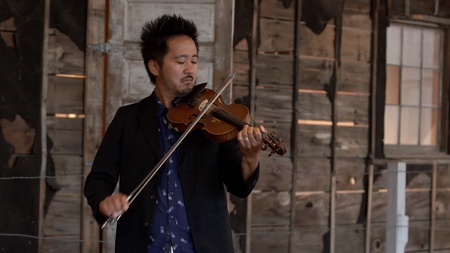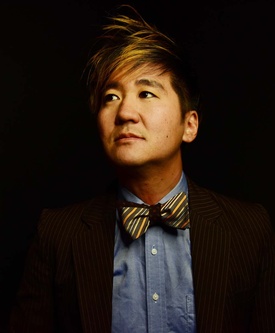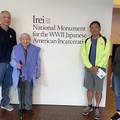Kishi Bashi at the Skirball Cultural Center on August 23, 2018.
Striding onto the Skirball Cultural Center’s Sunset Concert stage before a full house, Kishi Bashi (née Kaoru Ishibashi) picks up his violin and conducts the string players behind him with reserved but palpable authority. He expertly bows and strums the violin, confidently directs the accompanying strings, and opens up with a sweet sounding vocal that brings cheers from an audience that has clearly followed him from the release of his first solo album in 2014. In the tradition of rock bands like ELO (Electric Light Orchestra), he adds electronics to instruments typically associated with classical music. It’s refreshing to see a performer of Japanese descent take command on a Los Angeles stage over such a wildly enthusiastic audience.
Music has been in his blood from the time he began playing violin at age 7. Because it came naturally, he admits it soon formed his identity. So much so that he says he even used it as a “shield to hide behind.” Calling music a “colorblind” art form, he grabbed this armor as protection against feelings of being different. Flunking out of engineering school, he also began to understand how music bestowed self-worth when he was accepted to the prestigious Berklee College of Music, the premier school for contemporary music and the performing arts in the world. Kishi Bashi realized how lucky he was to have a gift and aptitude for something he loved.
It’s thus no surprise that music forms the backbone of his next ambitious project—a documentary he calls a “songfilm”—combining emotive music, soaring landscapes, first-person revelations, and insightful conversation. Telling a unique story about America through the eyes of this multifaceted musician, the film embarks on a bold quest to unravel the threads behind such elusive topics as racial prejudice, privilege, and cultural identity. His starting point is none other than the Japanese American mass incarceration.
The popular songmaker is a relative newcomer to the incarceration story. Considering himself an outsider to the Japanese American community on the West Coast, he spent his formative years in Norfolk, VA.
His parents had come individually to the U.S. after the war to study at the University of Washington. They eventually went on to join the ranks of academia, his father earning a Ph.D. in civil engineering and his mother a Japanese language instructor. Coming from the small rural village of Iga in Mie Prefecture (known as a training ground for ninja or ancient farmer/warrior clans), his father was looking to pursue his studies after getting a degree in engineering from Nagoya University.
In contrast, his mother would probably never have left her hometown of Okinawa had it not been for a program sponsored by the U.S. government program awarding scholarships to women. She had been given a full scholarship after her family endured a tumultuous period in Okinawan wartime history when the U.S. military attacked the small island. In what became the largest amphibious battle of the war, his grandmother survived after being conscripted by the Japanese government to serve in the Himeyuri nursing corps and forced to live in a cave while attending to the wounded. His grandmother’s sister was among 120,000 civilians who died in the brutal three-month battle.
With no family connection to the incarceration but a strong interest in Japan and U.S. history, Kishi Bashi realized he had only basic knowledge of these deeply personal wartime stories. Inspired to visit the Manzanar and Tule Lake incarceration sites after being commissioned by a symphony orchestra in Miami to do a multimedia piece, he began a journey to uncover the “whole part of me” that was borne of his bicultural identity. As a Shin-Nisei (second-generation Japanese immigrant), the dual narrative of being both Japanese and American made the project intriguingly his own.

He felt a commonality through ancestry with those who were incarcerated, and the U.S. wartime history predictably affected him. But he also wanted to explore what was happening in Japan. He realized there was a much deeper and more complicated story about how race and/or culture isolates people. He traveled both continents to discover the discrimination apparent on both sides—from the American government imprisoning people based on race to the Japanese government singling out Okinawans as militarily expendable.
The songfilm is called Omoiyari, a complicated term that is as indefinable as it is difficult for Westerners to pronounce (one of the film’s trailers features people of all colors, nationalities, and genders saying the word directly to the camera). A Japanese concept that cannot be easily translated in a word or phrase, it refers to the cultural notion of being considerate of the other, a term Kishi Bashi explains involves “going beyond empathy by implying action.” A definition that underlines its complexity was made by cultural anthropologist T.S. Lebra, who described omoiyari as “the ability and willingness to feel what others are feeling, to vicariously experience the pleasure or pain that they are undergoing, and to help them satisfy their wishes . . .without being told verbally.”1
Kishi Bashi intentionally strives to understand the feelings of the other and to go beyond racism, discrimination, confrontation, and war in the spirit of omoiyari. The songfilm becomes a vehicle to express what it means to be an American citizen living in a divided world, but more important, how to understand that world and hopefully move toward peace and equality. These lofty goals are hopefully achieved through a deeply personal journey. Caught between his Japanese and American dual identities, he attempts to understand all the complex feelings of his own divided self, using his persona as a tool for understanding the past and creating a better future. As an artist, he accomplishes this by incorporating music and rhyme. Quoting Mark Twain’s clever adage in “Omoiyari” to prove his point, “History doesn’t repeat itself, but it often rhymes.”
He hopes his music will provide the framework to go beyond anger and hate. When recently visiting the Heart Mountain incarceration center, he was moved by the words of Alan K. Simpson, the former U.S. Senator from Wyoming, who said, “Be a seeker, not a seether.” At age 42, Kishi Bashi is seeking and hopefully moving the world to do the same.
Note:
1. Lebra, T. S. (1976). Japanese patterns of behavior. Honolulu, HI: University of Hawaii Press, p. 38.
© 2018 Sharon Yamato








